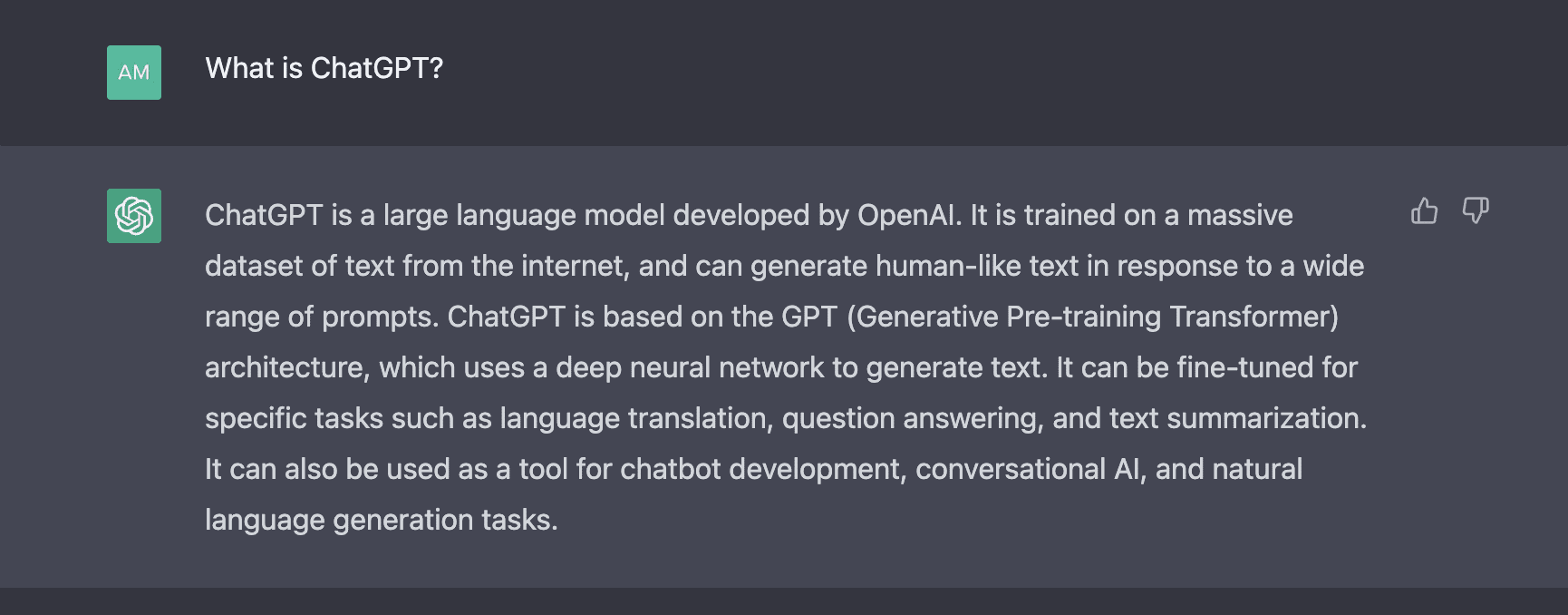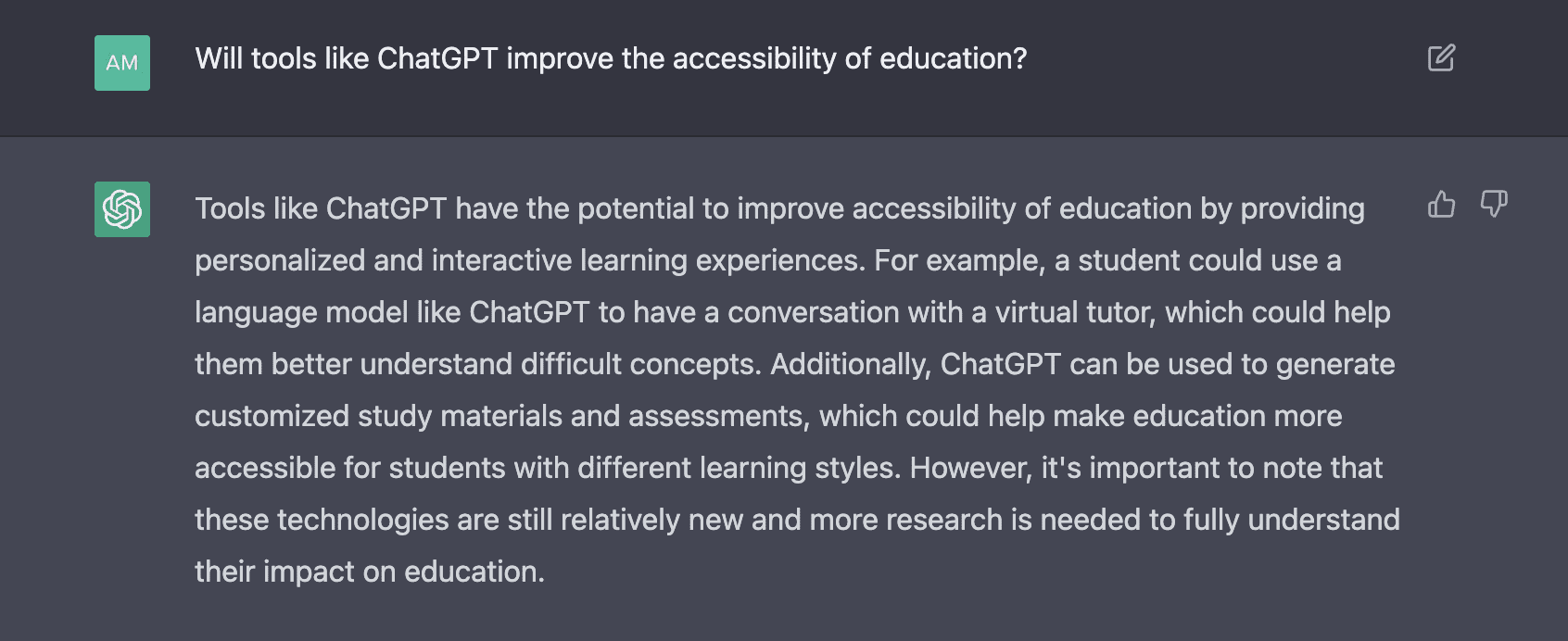The use of AI in education presents new opportunities for learning, teaching, and accessibility. However, the recent release of ChatGPT – the AI chatbot that produces human-like text – has sparked discussion and concern among educators. How can educators ensure students are learning if they use AI writing tools to complete assessments? This emerging technology requires educators to rethink assessments and integrate AI into learning and teaching. Teachers and students can benefit from a positive approach to AI as tools like ChatGPT are just the beginning. In this blog, we’ll look at what exactly ChatGPT is, how educators are tackling AI in education and the power of AI for improving accessibility.
What is ChatGPT?
In November 2022, OpenAI released ChatGPT – a chatbot that produces human-like text in response to users’ requests and questions. OpenAI is a research lab that aims to build natural, safe, and easy-to-use artificial intelligence (AI) that benefits humanity. ChatGPT is powered by OpenAI’s famous GPT-3, a powerful text generator trained using 175 billion parameters and around 500 billion words. This large and well-trained language learning model allows ChatGPT to ‘think’ and write like a human.
However, ChatGPT isn’t the first human-like text generator. The release of GPT-3 led to a range of AI writing tools such as Jasper and Copy AI. So, why has ChatGPT raised the most concern among educators and sparked such an interest? The difference is that this chatbot is free, interactive, and easily accessible. ChatGPT provides conversational-style responses and responds to follow-up questions on a range of topics. This chatbot can write essays, and poems, provide feedback and admit to mistakes. It’s like having a powerful virtual assistant at your fingertips.
Additionally, ChatGPT is more than an AI writing tool, it can also generate code, draw insights from data, and summarise information. It can also create lesson plans, prepare reading lists, write emails and more. Despite being so powerful, ChatGPT does have its limitations. The conversational responses are not always logical, factual, or current because the chatbot is limited to its training data.
However, ChatGPT’s release has highlighted that traditional learning and teaching will need to adapt. These limitations will likely be resolved and more chatbots and AI writing tools will emerge. That’s why educators, policymakers, and students should try to leverage the power of AI for improved learning outcomes.

The Concerns of AI in Education
Understandably, the release of ChatGPT caused some concern among educators. Students can use the chatbot to generate homework answers, write assessments, and complete take-home exams. Educators have tested their exams and assessments with ChatGPT and found it can produce high-quality answers that would pass. The text is so natural and human-like that it can be hard to distinguish whether it was written by a student or AI. This raises concerns over cheating and plagiarism.
Consequently, a range of schools and educational institutions have banned ChatGPT in the US. Many educators have also adopted GPTZero, an AI detection tool, created by university student Edward Tian. OpenAI and Turnitin are also working on watermarks and AI-detection features to make AI-generated content easier to detect. However, educators have noted that placing a ban on AI writers or policing their use will not prepare students for the real world and the upcoming job market. Instead, many institutions and educators are trying to rethink assessment methods alongside AI.
In addition, there have been concerns beyond plagiarism and cheating. Will AI writers reduce students’ writing skills? Writing is an important part of learning. It’s a process of thinking that supports critical reflection and thought. Yet, AI might not be the end of writing for students. It might simply be time to rethink traditional methods of teaching writing. In one blog, the author argues that AI writers could make way for more thoughtful writing assessments and teachers could encourage students to use AI writers to compare and contrast the outputs with their own writing. AI writers could free up time for educators to provide creative assessments and have the time to mark them with their own thoughtful feedback.
This highlights that it might be more beneficial to work with AI rather than against it. Instead of bans and restrictions, AI can improve learning outcomes and introduce new assessments. This could be a game changer for students, teachers, and the accessibility of traditional learning.
Adopting AI in Education
The sudden release of ChatGPT and the widespread excitement that occurred might feel sudden to students and some educators. However, the use of AI in education has been positively anticipated by experts. UNESCO’s recent publication covers detailed trends and implications for AI in education for policymakers and educators. This includes guidance on how AI can be used responsibly to enhance education. Notably, AI in education could be worth $6 billion by 2024 which highlights the importance of such guidance.
Institutions like Washington University are making efforts to educate their staff and integrate AIs like ChatGPT into assessments. This is a step in the right direction that will benefit staff and students to use AI responsibly. UNESCO and AI researchers are less worried about plagiarism and academic skills, Instead, their concerns rest on ensuring privacy and equal access to AI in education for all. This emphasises that we need to focus on adopting AI positively and with the right knowledge to manage the changes that AI will make to education.
Beyond AI writers, the use of AI in education can improve learning and accessibility in a variety of ways. In a recent review, AI has been noted to help tailor learning materials to students’ learning needs, enhance distance learning, and support teacher feedback through automatic grading. This could improve the accessibility of learning for neurodivergent students and those with learning difficulties.

The Power of AI for Learning Difficulties and Neurodivergent Students
The use of AI in education has the power to transform the accessibility of learning. For neurodivergent students or those with learning difficulties, reading, writing, and note taking can be a challenge. This can be due to a range of deficits in language and information processing. AI in education could provide students with text-based assistance for reading, writing, and note taking. The use of AI in education can be used to provide tailored learning experiences across abilities. This would make it easier for teachers to provide instructions and feedback across their classrooms with the support of AI.
These developments have the potential to reduce the stress and anxiety faced by students. Instead, AI can provide stepping stones for students of all abilities to excel and achieve. AI tools will allow students to learn at their own pace and adopt independent learning. Additionally, these tools can make the traditional learning environment more accessible, allowing students to collaborate with their peers.
Jamworks: AI-Powered Assistive Note Taking
Jamworks, an assistive note taking and lecture recording tool, is one example of how AI can be positively used in education. For students of all abilities, Jamworks provides a simple, easy, and distraction-free way to take notes during lectures. This can be essential for students who struggle with information processing, language comprehension, writing difficulties, and poor attention spans. Note taking requires careful attention and the ability to multitask well. This can make lectures inaccessible for students with learning difficulties or those that are neurodivergent.
However, lectures are currently an essential source of learning material. That’s why Jamworks provides a simple assistive note taking solution for students to excel in their studies. Students can record their lectures using Jamworks and use 1-button highlighting to break lecture material down into key topics. For each highlight, students can write their own notes and attach resources. This simple 1-button highlighting method allows students to focus on listening and understanding while capturing everything.
AI for Review and Revision
Jamworks then leverages the power of AI to produce smart summaries of those highlights. Summaries make it easier for students to review the material they need. These highlights can also be reviewed as an audio clip or word-for-word transcript. This leaves students with well-organised notes that are easy to review and provides comprehensive notes for revision and assignments. For students with learning difficulties like dyslexia, a lack of personal lecture notes can be a significant barrier to learning.
Finally, Jamworks supports students to memorise materials using Flashcard-style quizzes. Students can take a quiz using their lecture highlights. Flashcard-style quizzes encourage students to use active recall, one of the best revision techniques for memorising material. Jamworks streamlines the student’s learning process and allows them to focus on applying their knowledge in assignments and exams.
If you’re a student interested in using Jamworks’ AI-powered tool to assist your studies, click here to get started.
If you work as a DSA Needs Assessor, click here for more info about how Jamworks can support students with additional needs.